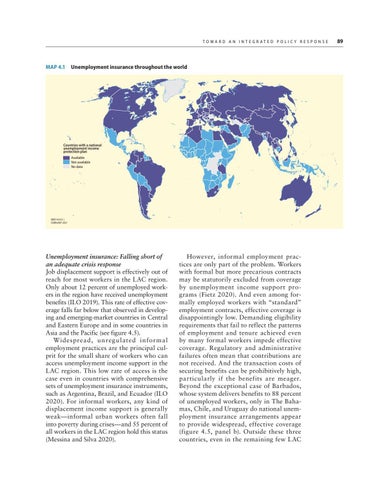T o w a r d a n I n t e g r a t e d P o l i c y R e s p o n s e
MAP 4.1 Unemployment insurance throughout the world
Countries with a national unemployment income protection plan Available Not available No data
IBRD 45553 | FEBRUARY 2021
Unemployment insurance: Falling short of an adequate crisis response Job displacement support is effectively out of reach for most workers in the LAC region. Only about 12 percent of unemployed workers in the region have received unemployment benefits (ILO 2019). This rate of effective coverage falls far below that observed in developing and emerging-market countries in Central and Eastern Europe and in some countries in Asia and the Pacific (see figure 4.5). Widespread, u n reg u lated i n formal employment practices are the principal culprit for the small share of workers who can access unemployment income support in the LAC region. This low rate of access is the case even in countries with comprehensive sets of unemployment insurance instruments, such as Argentina, Brazil, and Ecuador (ILO 2020). For informal workers, any kind of displacement income support is generally weak—informal urban workers often fall into poverty during crises—and 55 percent of all workers in the LAC region hold this status (Messina and Silva 2020).
However, informal employment practices are only part of the problem. Workers with formal but more precarious contracts may be statutorily excluded from coverage by unemployment income support programs (Fietz 2020). And even among formally employed workers with “standard” employment contracts, effective coverage is disappointingly low. Demanding eligibility requirements that fail to reflect the patterns of employment and tenure achieved even by many formal workers impede effective coverage. Regulatory and administrative failures often mean that contributions are not received. And the transaction costs of securing benefits can be prohibitively high, particularly if the benefits are meager. Beyond the exceptional case of Barbados, whose system delivers benefits to 88 percent of unemployed workers, only in The Bahamas, Chile, and Uruguay do national unemployment insurance arrangements appear to provide widespread, effective coverage (figure 4.5, panel b). Outside these three countries, even in the remaining few LAC
89

